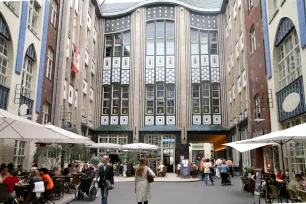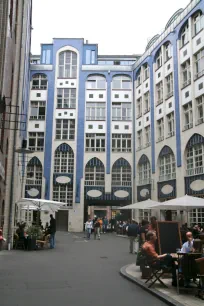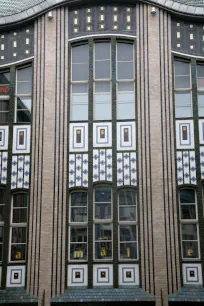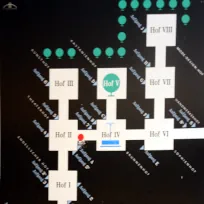A series of courtyards joined together to form one large complex with multiple uses, Hackesche Höfe is one of Berlin’s most popular tourist attractions and is a favorite of locals as well.
The Höfe in Berlin

Hackesche Höfe was built in the early 1900s, when the design of such courtyards was the norm for Berlin. At the time, Berlin was growing rapidly into a metropolis of more than two million inhabitants and was the most densely populated city in the world. To accommodate the growing number of inhabitants, large housing blocks were built around interconnecting courtyards, which allowed for more people to live on a single city block.

Construction of the Hackesche Höfe
The Hackesche Höfe was the largest of these interlinked courtyards. It was built on a large plot at the corner of Rosenthaler Straße and Oranienburger Straße in the Scheunenviertel Quarter. The plot was owned by the glassware manufacturer Hans Quilitz. Built between 1906-1907 by the developer and architect Kurt Berndt, the new complex combined residential housing, factories and offices.
The complex was built around eight inner courtyards. The offices faced the street, and a banqueting hall bordered the first courtyard. The second and third courtyards contained multi-story factories, while the remaining courtyards contained tenement housing.
Architecture

The quality of living in the Hackesche Höfe was quite high for its time, and the architecture of the courtyards reflected the developer’s ambitions. This is apparent in the decoration of the facades, in particular those around the main courtyard (Hof I) which were the work of the Berlin designer and architect August Endell.
Endell favored Jugendstil, a local variant of the Art Nouveau style. The German emperor however disliked Jugendstil, so it was rarely used in Berlin. However, since the courtyard wasn’t visible from the street, Endell wasn’t hindered by such political constraints, and he fashioned the whole courtyard in enameled tiles with a Jugendstil pattern.
The other courtyards aren’t quite as fancy, but of note is the second courtyard, which was covered with white glazed tiles to create more light for the factories that were housed here. Some of the residential courtyards feature trees and fountains.
Hackesche Höfe Today

In 1940 the complex was foreclosed, and it was hit by bombs during the Second World War. After the war it became state-owned and in 1961 the street facade was renovated. In 1977 Hackesche Höfe became a protected monument, but it wasn’t until 1995, after the reunification of Germany, that an extensive restoration of the complex was started.
Two years later, Hackesche Höfe was looking better than it ever had, and it soon became a popular meeting place. Today it is one of the trendiest spots in central Berlin, boasting cafés, restaurants and shops that attract tons of locals and visitors each day.

Hof I, also known as the Endellscher Hof, includes a cinema, several bars and restaurants, and the very popular Chameleon Theatre (Chamäleon Variété), a variety theater where it’s not unusual to see everything from tap dancing to vaudeville on stage. Hof 2, also known as the Theatrehof, houses the Hackesche Höfe Theatre, as well as several offices. The smaller remaining courtyards are much quieter and feature small shops and galleries.
- Next: Bebelplatz
- More Sights & Attractions in Berlin

